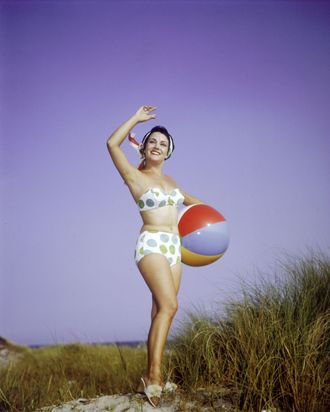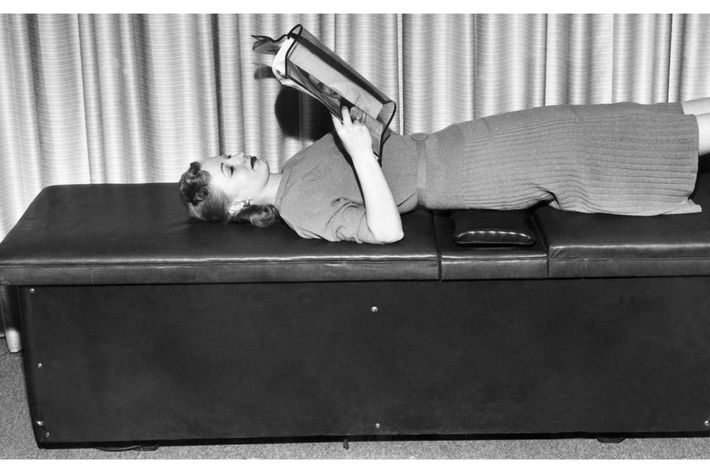
Every summer, tabloids and women’s magazines bombard us with news of “bikini bodies,” a predictable ritual with an equally predictable response: Jezebel recently dismissed the term as “infuriating bullshit,” while a Huffington Post quiz promised women that having a “bikini body” requires just a bikini and a body.
Yet, despite these efforts, the fact remains that bikini body conjures a specific image: a thin, fit female body, perhaps belonging to Gisele or Beyoncé, and almost certainly not belonging to you. The women whose figures we idolize have changed over time, but the idea that only certain bodies are worthy of the title bikini has been used in articles and advertising language for over 50 years.
The term bikini body was first popularized in a 1961 ad campaign by a chain of weight-loss salons called Slenderella International, according to linguists consulted for this story, as well as public records. “Summer’s wonderful fun is for those who look young,” read a Slenderella ad that ran in in outlets like the New York Times and the Washington Post in the summer of 1961. “High firm bust — hand span waist — trim, firm hips — slender graceful legs — a Bikini body!”
“The ad seems to reflect the functions of ‘bikini body’ that feminists critique: Shaming women whose bodies do not fit an idealized body type,” says Nicholas Subtirelu, a linguist at Georgia State University. Slenderella promoted “passive exercise,” claiming clients could drop several sizes simply by lying on vibrating tables. The chain didn’t just have trouble adhering to principles of science, but to tenets of the law as well: The IRS accused the company of evading taxes, and the Better Business Bureau campaigned against its misleading advertisements.

Before long, other weight-loss companies began talking about “bikini bodies,” too. In a 1963 ad in the Chicago Tribune, a salon called Suddenly Slenda promised women they could achieve “a bikini body for summer” by undergoing some sort of wrapping ritual that, from the illustration, looks a lot like getting TP’d. Or, as Slenda put it: “A trained technician applies our exclusive Contour Cloth to the area you want slenderized. You relax on a comfortable lounge for 90 minutes while the Contour Cloth works its magic.” In 1970, an ad for “Pretty Body,” a “figure salon” on West 56th Street between Fifth and Sixth avenues, ran in New York and claimed to help women achieve “a firmer, slimmer, sexier body … a bikini body” through “flesh firming machines.”
In spite of these advertising messages, the term bikini body didn’t really catch on for another couple of decades. By the time it popped up again, in the late 1980s, it was no longer confined to marketing materials, but had crossed over into everyday language. In 1988, a self-described “handsome adventurer” wrote of his preference for a woman with a “bikini body” in the classified section of the New York Times. In the 1992 novel Mercy by Echo Heron, a boy admires a girl’s “perfect bikini body.”
“It strikes me as a word fad that has become fashionable from time to time and then gone dormant again for a while,” says Orin Hargraves, a linguist at the University of Colorado, Boulder. Hargraves analyzed data from the Corpus of Historical American English and observed spikes in the popularity of “bikini body” in 1962, 1990, and 1994. It’s been on the rise since the early 2000s, though, even if a handful of those instances are due to places like the Huffington Post and Jezebel critiquing its very existence.
The oral history of the phrase is harder to trace. The bikini itself was invented in 1946, around the same time as the United States detonated a nuclear bomb above the Bikini Islands. Linguists dispute its etymology, but according to the most commonly held opinion, the bikini’s designers were trying to draw a parallel between the explosive bomb and the racy new swimsuit. Whether or not people had spoken of a “bikini body” by the time Slenderella wrote about it in 1961, it must have been unusual enough that the advertisers felt the need to define it (“high firm bust,” “slender legs,” et cetera). But Hargraves says its meaning is self-evident to English speakers, adding that, however odious the concept, “bikini body” has a ring to it. “Alliteration always makes a phrase a bit more memorable and likely to gain traction,” he said.
Will bikini body ever sound as dated as “vibrating exercise tables” or “flesh-firming machines”? It doesn’t seem likely. What started as a slogan for a fraudulent company has endured for over half a century, becoming a part of our vocabulary and our culture. Its reach extends far beyond the beach: Bikini-body diets and bikini-body workouts mean we’re thinking about skimpy swimwear in the kitchen and the gym as well as the dressing room and the beach. Or, as Jezebel might put it, nowhere are we free from the “iron-fisted tyranny of the ‘bikini body.’”




